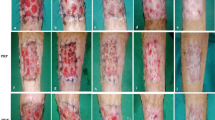Abstract
Skin grafts can be used effectively to cover burn injuries. A critical element of this treatment is the adherence of the graft to the wound bed. Honey has been shown to increase the adherence of skin grafts to wound beds and have antibacterial and anti-inflammatory effects and increase healing rate of wounds. We therefore devised a clinical trial to determine the effect of honey on skin graft fixation in burn injuries. Sixty patients were included in this study (in 30 patients, graft was fixed with medical honey, and in 30 patients, it was fixed with dressing or suturing). All patients in two groups were evaluated for infection, graft loss, graft contraction, severity of pain, and need for re-operation. The most common cause of burn was kerosene. Honey significantly decreased infection rate on fifth day and reduced the patient pain. The mean hospital stay was shorter in honey group. Contraction of graft was significantly less in honey group. Honey has strong adhesive properties for skin graft fixation. Medical honey is a natural material, not synthetic. For this reason, we can advise the application of medical honey for the fixation of split thickness skin graft.




Similar content being viewed by others
References
Majno G (1975) The healing hand. Man and wound in the ancient world. Harvard University Press, Cambridge, MA, p 571
Ransome HM (1937) The sacred bee in ancient times and folklore. Allen & Unwin, London, p 308
Gunther RT (1959) The Greek herbal dioscorides. Hafner, New York [Goodyear J, trans.]
Zumla A, Lulat A (1989) Honey—a remedy rediscovered. J R Soc Med 82:384–5
Allen KL, Molan PC, Reid GM (1991) A survey of the antibacterial activity of some New Zealand honeys. J Pharm Pharmacol 43:817–22
Bergam A, Yanai J, Weis J et al (1983) Acceleration of wound healing by topical application of honey: an animal model. Am J Surg 145:374–6
Maghsoudi H, Moradi S. Comparison between topical honey and mafenide acetate in treatment of burn wounds. Annals of burns and fire disasters - vol. XXIV - n. 3 -September 2011
Obaseiki-Ebor EE, Afonya TCA (1983) Preliminary report on the antimicrobial activity of honey distillate. J Pharm Pharmacol 35:748–9
Efem SEE (1988) Clinical observations on the wound healing properties of honey. Br J Surg 75:679–81
Cooper R, Molan PC (1999) The use of honey as a antiseptic in managing Pseudomonas infection. J Wound Care 8:161–4
Molan PC (1999) The role of honey in the management of wounds. J Wound Care 8:415–8
Postmes T, Bosch MMC, Dutrieux R et al (1997) Speeding up the healing of burns with honey. An experimental study with histological assessment of wound biopsies. In: Mizrahi A, Lensky Y (eds) Bee products: properties, applications and apiotherapy. Plenum Press, New York, pp 27–37
Postmes T, Boogaard AE, van den Hazen M (1993) Honey for wounds, ulcers, and skin graft preservation. Lancet 341:756–7
Subrahmanyam M, Archan M, Pawar SG (2001) Antibacterial activity of honey on bacteria isolated from wounds. Ann Burns Fire Disasters 14:22–4
Postmes T, van den Boogaard A, Hazen M (1995) The sterilization of honey with cobalt 60 gamma radiation: a study of honey spiked with spores of Clostridium botulinum and Bacillus subtilis. Experientia 51:986–9
Molan PC, Allen KL (1996) The effect of gamma-irradiation on the antibacterial activity of honey. J Pharm Pharmacol 48:1206–9
Molan PC (1996) Honey as an antimicrobial agent. In: Mizrahi A, Lensky Y (eds) Bee products. Plenum Press, New York, pp 27–37
Bogdanov S (1996) Non-peroxide antimicrobial activity of honey. In: Mizrahi A, Lensky Y (eds) Bee products. Plenum Press, New York, pp 39–47
Tovey FI (2000) Honey and sugar as a dressing for wounds and ulcers. Trop Doct 30:1, Editorial
Snowdon JA, Cliver DO (1996) Micro-organisms in honey. Int J Food Microbiol 31:1–26
Birch J, Branemark PI (1969) The vascularization of a free full thickness skin graft: a vital microscopic study. Scand J Plast Surg 3:1
Converse JM, Rapaport FT (1956) The vascularization of skin autografts and homografts: an experimental study in man. Ann Surg 143:306
Haller JA, Billingham RE (1967) Studies of the origin of vasculature in free skin grafts. Ann Surg 166:896
Rudge R (2007) An easy and safe method of split-thickness skin graft fixation. Burns 33:1074–5
Mah E, Morrison WA (2006) A stitch in time (save mines). Plast Reconstr Surg 117:2535–6
Yenidünya MO, Özdengill E, Emsen I (2000) Split-thickness skin graft fixation with surgical drape. Plast Reconstr Surg 106:1429–30
Alexander G, Al-Rasheed AA (2005) Skin stapler removal by artery forceps: a hazardous practice? Burns 31:116
Adler N, Nachumovsky S, Meshulam-Derazon S, Ad-El D (2007) Skin graft fixation with cyanoacrylate tissue adhesive in burn patients. Burns 33:803
Mohammadi A, Johari HG (2008) Amniotic membrane: a skin graft fixator convenient for both patient and surgeon. Burns 34:1051–2
Dunford C (2005) The use of honey-derived dressing to promote effective wound management. Prof Nurse 20(8):35–8
Author information
Authors and Affiliations
Corresponding author
Rights and permissions
About this article
Cite this article
Maghsoudi, H., Moradi, S. Honey: A Skin Graft Fixator Convenient for Both Patient and Surgeon. Indian J Surg 77 (Suppl 3), 863–867 (2015). https://doi.org/10.1007/s12262-014-1039-0
Received:
Accepted:
Published:
Issue Date:
DOI: https://doi.org/10.1007/s12262-014-1039-0




